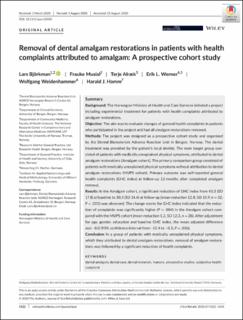| dc.description.abstract | Background
The Norwegian Ministry of Health and Care Services initiated a project including experimental treatment for patients with health complaints attributed to amalgam restorations.
Objective
The aim was to evaluate changes of general health complaints in patients who participated in the project and had all amalgam restorations removed.
Methods
The project was designed as a prospective cohort study and organised by the Dental Biomaterials Adverse Reaction Unit in Bergen, Norway. The dental treatment was provided by the patient's local dentist. The main target group consisted of patients with medically unexplained physical symptoms, attributed to dental amalgam restorations (Amalgam cohort). The primary comparison group consisted of patients with medically unexplained physical symptoms without attribution to dental amalgam restorations (MUPS cohort). Primary outcome was self‐reported general health complaints (GHC index) at follow‐up 12‐months after completed amalgam removal.
Results
In the Amalgam cohort, a significant reduction of GHC index from 43.3 (SD 17.8) at baseline to 30.5 (SD 14.4) at follow‐up (mean reduction 12.8, SD 15.9; n = 32; P < .001) was observed. The change scores for GHC index indicated that the reduction of complaints was significantly higher (P = .004) in the Amalgam cohort compared with the MUPS cohort (mean reduction 1.2, SD 12.3, n = 28). After adjustment for age, gender, education and baseline GHC index, the mean adjusted difference was −8.0 (95% confidence interval from −15.4 to −0.5; P = .036).
Conclusion
In a group of patients with medically unexplained physical symptoms, which they attributed to dental amalgam restorations, removal of amalgam restorations was followed by a significant reduction of health complaints. | |

